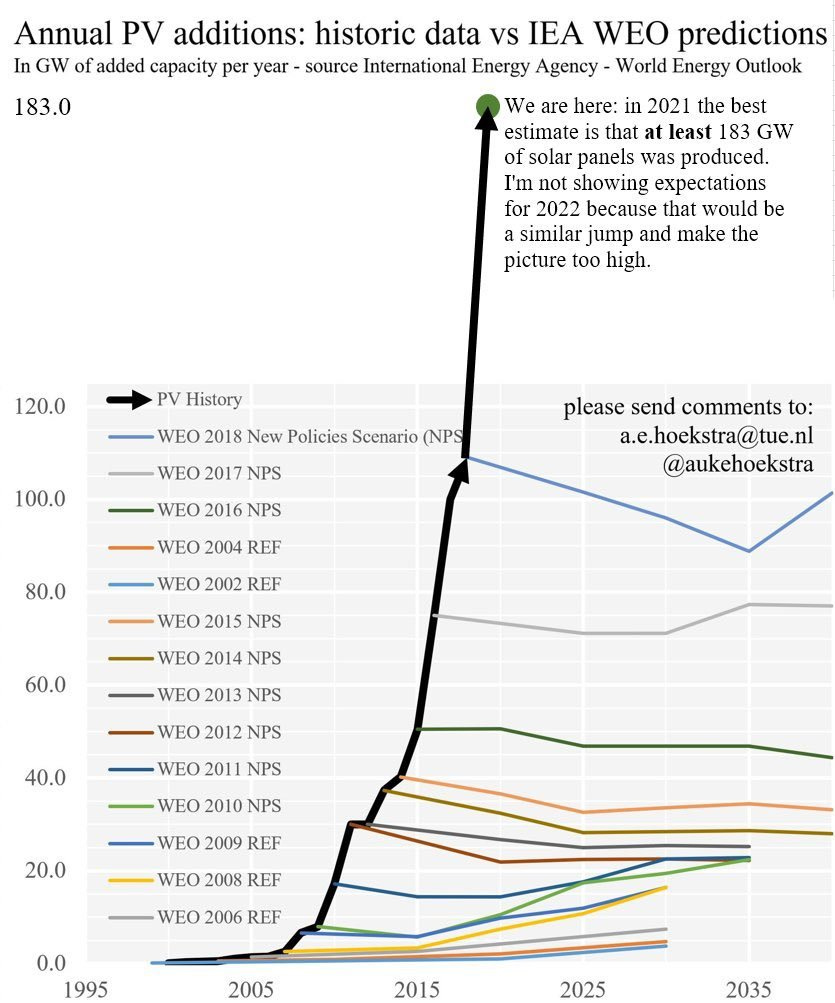Hello all,
This week’s Energy Charts are posted at https://aleach.ca/charts.
It’s been really interesting week back in the classroom for me, and there’s been lots going on in Canadian energy too.
This week, our students have 3 great links for you. Kayla’s got the timely story of the week with a look at Canadian LNG and the visit of the Prime Minister of Japan (more on that below). Marc’s got a piece on rare earth mining for renewable energy. And Yousaff is featuring the IEA Renewables 2022 report.
When talk turns to the IEA and renewable power, I’m always reminded of Auke Hoekstra’s famous graph, reproduced below. The degree to which major energy forecasts have missed the booming renewable energy market is lamentable, and it’s not even clear that we’re getting better at it. We might, in fact, be getting worse. As Yousaff points out, the IEA’s forecast has been (again) revised upwards this year, but the question is whether it’s been revised upwards enough. If history is any guide, the answer is no.
Other than this graph, I have a few other things to share this week.
First, I hope you had a chance to read my CBC piece on the so-called just transition this week. I tried to combine a bit of history, a mention of the Miramichi (one of my favorite places on earth), and a bit of scorn for both Prime Minister Trudeau and Premier Smith’s approach to this file.
Next, with respect to the business case for LNG in Canada, I ran across a graph I hadn’t noticed before in the IEA’s World Energy Outlook 2022 while prepping for class this week.
It shows three LNG demand scenarios, under the IEA’s current policies (STEPS), announced pledges (APS) and net-zero (NZE) scenarios compared with capacity currently-operating and in-construction. It’s stark. The message is clear: in the IEA’s view, at least on average, new LNG capacity is a bet against action on climate change. Now, this needs to be taken with a bit of a grain of salt. Gas use in aggressive climate mitigation scenarios is subject to really large uncertainty, as shown below (the scenarios get less climate-friendly as you go from left to right).
Still, the long-run business case for new Canadian LNG in a world acting aggressively on climate change is far from certain. It is possible that the world will follow a gas-based decarbonization, at least in the medium term. But, it’s also plausible that the combination of local supplies and gas alternatives mean that there is a limited role for LNG in a climate-constrained world.
Next, it’s STEO week, so I’d be remiss if I didn’t re-post my favorite oil demand graph from that report, tracking changes in forecasts since COVID was first reported. The picture remains one of an incomplete recovery, even with renewed activity in China.
And, finally, while I won’t bore you with a long rendition on the constitutionality of a federal cap on oil and gas emissions, a couple of things that the Premier has said on the topic this week are, at least in my view, incorrect. As she’s quoted in this column by Chris Varcoe, the premier feels that:
“If you end up having an emissions cap that is too short a timeframe and the technology is not available, it acts as a de facto production cap…and that’s clearly offside with the Constitution.”
There is, at least based on my research in the area, nothing which would suggest that this specific statement is true. Federal policies including taxes, emissions pricing, fisheries legislation, and environmental standards affect resource production in the provinces all the time. Federal legislation can’t be specifically in relation to the primary production from natural resources in the provinces, but it can most certainly affect resource production. For example, consider the Supreme Court of Canada decision in Quebec (Attorney General) v. Moses in which the Court was to determine (among other things) whether the federal government could require a fisheries permit for a vanadium mine. The answer from the Court is an unequivocal yes - the province can legislate in relation to mining, but section 92A offers no immunity from the application of federal fisheries legislation:
[36] There is no doubt that a vanadium mining project, considered in isolation, falls within provincial jurisdiction under s. 92A of the Constitution Act, 1867 over natural resources. There is also no doubt that ordinarily a mining project anywhere in Canada that puts at risk fish habitat could not proceed without a permit from the federal Fisheries Minister, which he or she could not issue except after compliance with the CEAA. The mining of non‑renewable mineral resources aspect falls within provincial jurisdiction, but the fisheries aspect is federal.
The question for a future court will be whether an oil and gas emissions cap is valid federal legislation, and it may or may not find as the Premier hopes. However, whether or not such an emissions cap causes oil production to be lower than it might otherwise be is unlikely to be a key determinant for the Court. To read more on the history of s. 92A, you can read my paper with Nigel Bankes on the subject here.
Have a great week.







The graph is, literally, a graph of actual installed capacity vs. forecast installed solar capacity. It's not in any way misleading.
Using the same metric, you'd likely find that nuclear capacity has grown by less than forecast over the same timeframe given unexpected shut-ins.
And, no, capacity of a non-dispatchable energy source is not useless. It's just not dispatchable.
Thanks for reading
If one considers emissions regulations to be a marginal cost of production (it is in terms of fines or necessary technology improvements in order to adhere) then it will indeed impact max production.